“Humor is a soul’s weapon in the fight for self-preservation,” reflected Viktor Frankl, a former prisoner of Nazi concentration camps and psychiatrist. Scientists also assert that laughter boosts immunity, improves heart health, enhances sleep, and reduces stress. But what is the other side of humor? Could it be part of propaganda? Yes. This method isn’t new; it even has a name – “hahaganda”. Since the beginning of the major war, Russia has actively used it. Below, we explain how the Kremlin advances toxic narratives through humor and why they are dangerous.
What is “hahaganda”, and how did it emerge?
“Hahaganda” is propaganda through humor. Systematic mockery using offensive language aims to undermine trust in someone or something, such as an individual, organization, or state. The term “hahaganda” was introduced by Latvian scholar Solvita Denisa-Liepniece in 2010.
In some ways, “hahaganda” can be seen as satire – sharp criticism with elements of humor. It has long been used as a tool for political agitation. For instance, satire was employed by mass political movements during the Reformation and Enlightenment in the 16th-18th centuries to either gain or maintain power.
Satire was also popular in dictatorial regimes like Nazi Germany or the USSR, where caricatures were its classic form. For example, Joseph Goebbels, who later became Minister of Propaganda in the Nazi government, published caricatures in the daily German newspaper Der Angriff. These caricatures were even compiled into three books to ridicule and discredit the resistance movement. One major target of such “humor” was Jews, depicted as short, overweight, smelly, with large noses.
A 1934 caricature in Die Brennessel showed two scenes: at the top, a Jewish banker seizes a German farm; at the bottom, a policeman strikes the Jew’s hand to force him to return the stolen property. Such “humor” spread antisemitic sentiments and the narrative of Jewish greed. Moreover, during this period, Germany was actively implementing racial policies, including banning Jews from certain positions. These caricatures helped shape public opinion.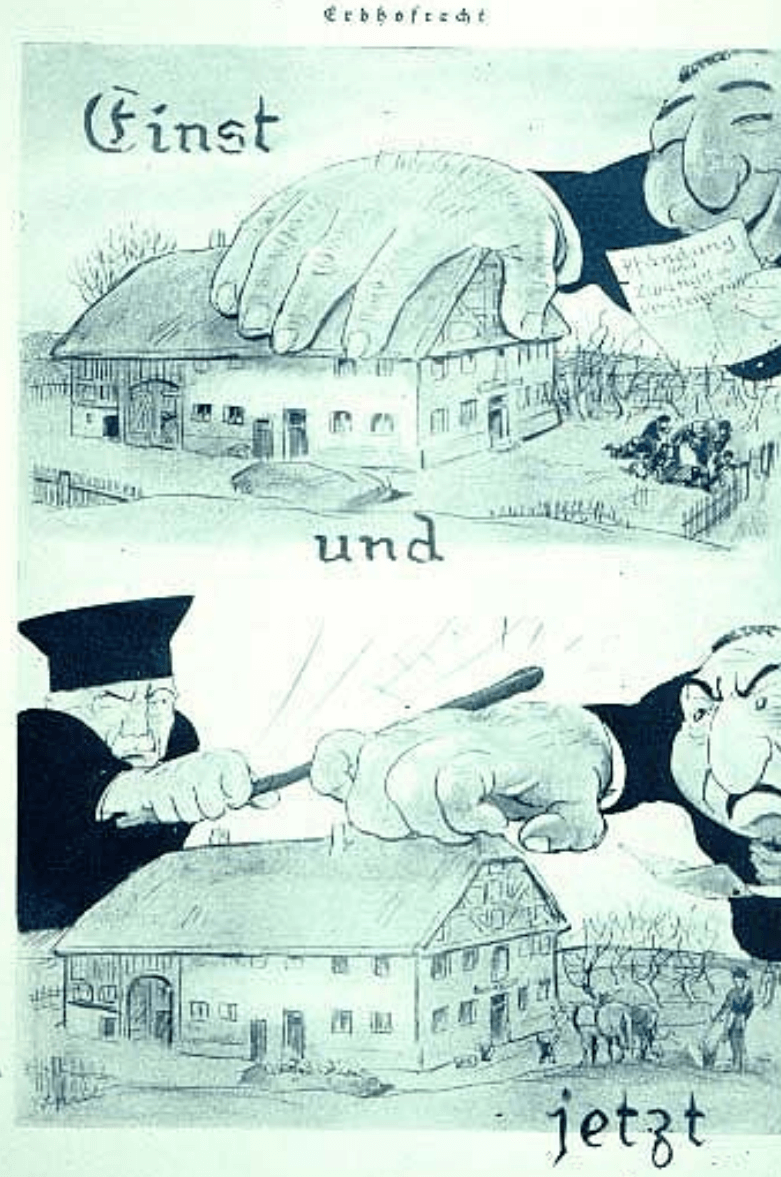
An example of an anti-Semitic caricature created by the German publication Die Brennessel in 1934. Source: The Joke is on Hitler: A Study of Humor under Nazi Rule.
How does Russia use “hahaganda” against Ukraine?
Russia uses humor in a similar style, i.e., “hahaganda”, to discredit Ukraine, refugees, international partners, and more. They create fake magazine covers, memes, cartoons, and even use artificial intelligence. Below, we analyze key tools of Russian “hahaganda”.
Magazine Covers
Ordinary text messages no longer have the same level of trust as they once did. Thus, Russian propagandists invent new ways to divert attention from their army’s invasion to Ukraine’s “troubles”. To amplify the effect, they use humor and covers of global media. These are disseminated not only in Russian Telegram channels but also in English-speaking information spaces to influence foreigners’ perceptions of Ukraine.
They often use real magazines as a base, replicate their style, and alter the cover. These mock covers not only ridicule Ukrainians but also promote the same narratives echoed by Kremlin mouthpieces like Solovyov and Skabeeva. The central tactic of Russian propaganda remains: the more frequently a lie is repeated, the sooner it is believed.
One such narrative involves the alleged “destruction” of Ukrainian Armed Forces (UAF) by Ukraine’s top political and military leadership. For instance, in February 2024, Russians circulated a fake cover of the German magazine Titanic featuring former UAF Commander Valerii Zaluzhnyi, seemingly “mocking” Ukrainian soldiers. This was clearly fake; the real issue depicted a German in a bird costume.
Russians also target Volodymyr Zelenskyi. For example, one fake cover of the German magazine Eulenspiegel depicted him as a “puppet” of the West.
Beyond state discreditation, Russians began adapting their fake covers to current events. After the Ukrainian Defense Forces’ advance in the Kursk region in August 2024, propagandists disseminated a fake Handelsblatt cover about “heavy losses” of the UAF in the region. The real cover had no mention of the Kursk events. With such fakes, the Russians aim to show the “greatness” of Russia, which allegedly repelled the Ukrainian Armed Forces’ offensive in Kursk, and to instill greater trust in ordinary Russians, propagandists used the world media.
When actual global media become tiresome, Russians create their own, like Rodib Reb. This magazine doesn’t exist, but its covers, featuring Zelenskyi, Ukrainian soldiers, and refugees, frequently appear in Russian Telegram channels.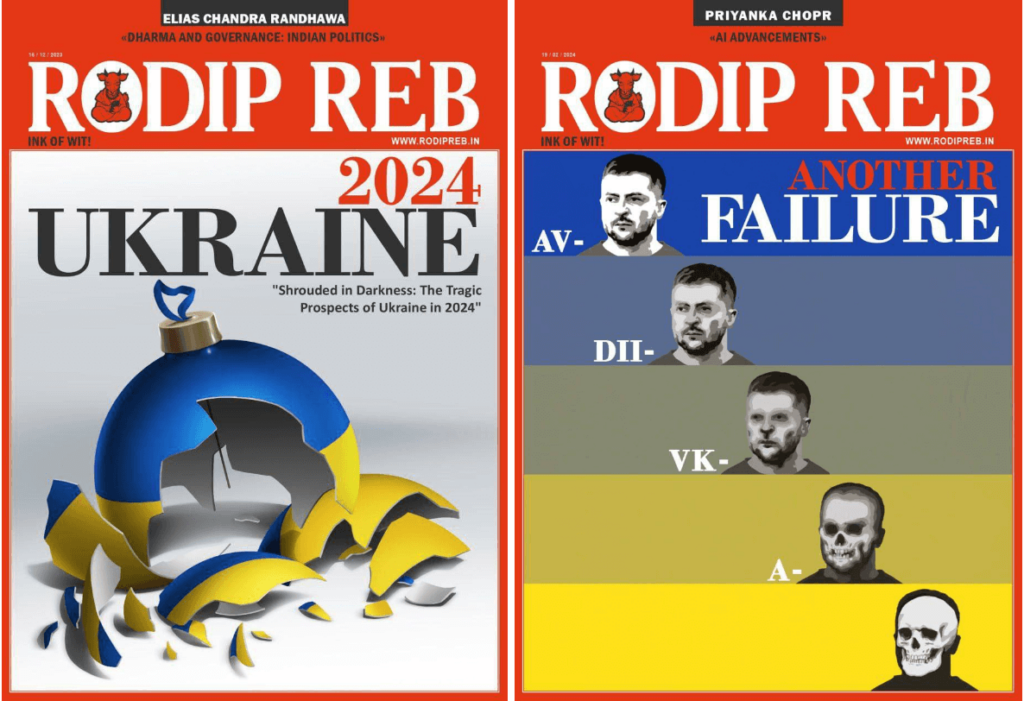
Why fake foreign publications when Russians are constantly told how “bad” the West is? Primarily to show that even Russia’s “enemies” agree with its rhetoric, strengthening audience impact. Secondly, to create an illusion of “credible sources” that lend greater legitimacy to propagandists’ claims.
Cartoons
A person sees a cover, laughs, and quickly forgets. Moreover, almost all of them are in foreign languages, so the reader may not always understand the context and is unlikely to share them with acquaintances who don’t know, for example, English or German. Cartoons, however, are a different story. Even without understanding the language, one can grasp the storyline through the actions of the main characters, especially when someone is mocked or discredited.
In 2022, Russian media actively circulated a cartoon from the Israeli channel INN. It portrayed Ukrainians as arrogant piglets and “Nazi refugees” who allegedly damage EU buildings and rob them. As a result, the EU throws Ukrainians out. But, as “classics” of Russian propaganda (or rather, Putin) claim, Russia naturally comes to the “rescue of poor Ukrainians”.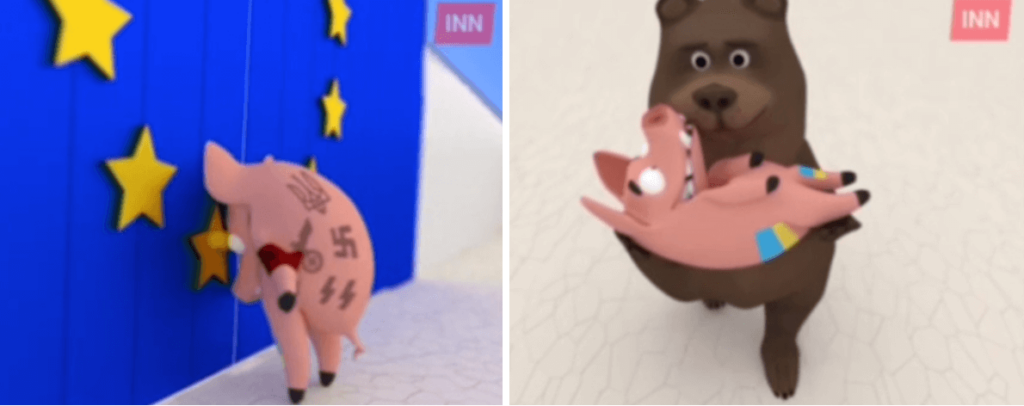
Frames from the fake cartoon allegedly from the Israeli channel INN, circulated by Russians
In reality, the Israeli channel INN did not publish such a video. Moreover, the INN logo used in the video belongs not to an Israeli channel but to an Indian news network with the same name. However, they, too, did not create the propagandist cartoon about Ukrainians.
It is worth noting that such cartoons do not always mock Ukrainians but also depict them as aggressors and “occupiers”, which in reality are the Russians. For example, the “French animation studio” Barracudas created a cartoon titled Stop Nazi Games. The plot centers on Volodymyr Zelenskyi, allegedly a puppet of Western rulers, launching an attack on Donbas using Azov and Right Sector soldiers.
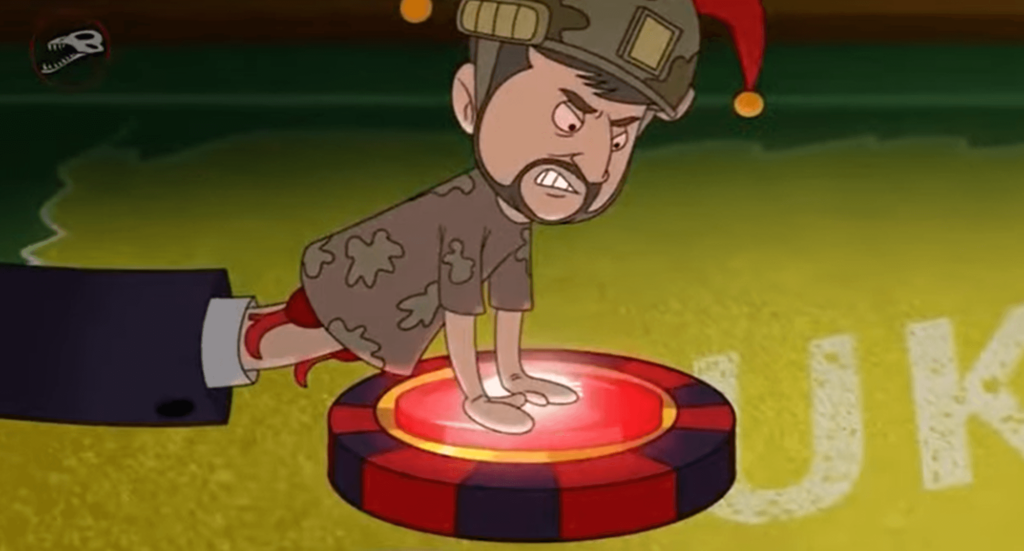
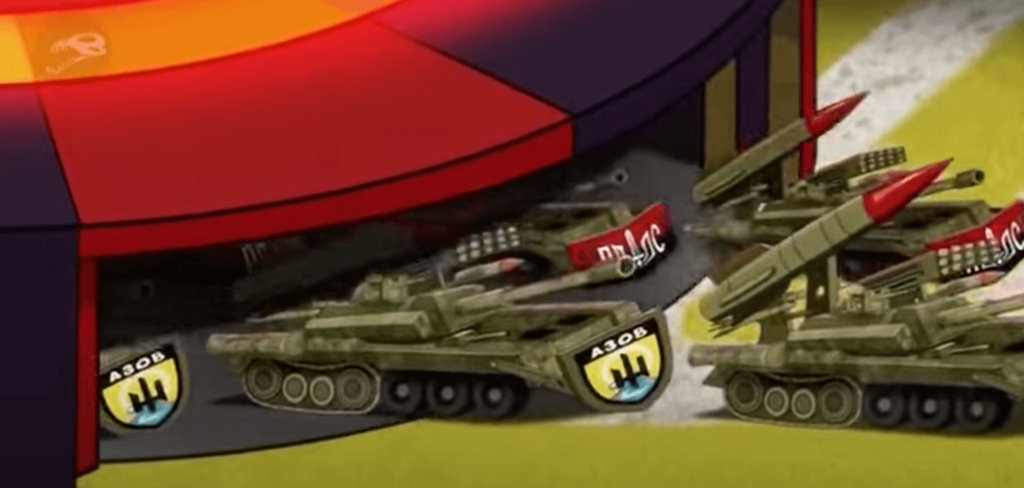
Screenshots from a fake cartoon circulated by Russians
This is also a product of Kremlin propagandists’ imagination. No open sources contain any information about the so-called “Barracudas” studio apart from the cartoon about “Nazi Ukraine”. The studio has no website or social media accounts.
Furthermore, it is likely that the inspiration for this video came from the Kill Dim cartoon series by Armenian animator David Saakyan. In that series, Azerbaijan is portrayed as a puppet of Turkey and a threat to Armenia’s security. Both videos share similar music and themes; for example, in one case, Zelenskyi, and in the other, Azerbaijani President Ilham Aliyev, are depicted as puppets on a hand.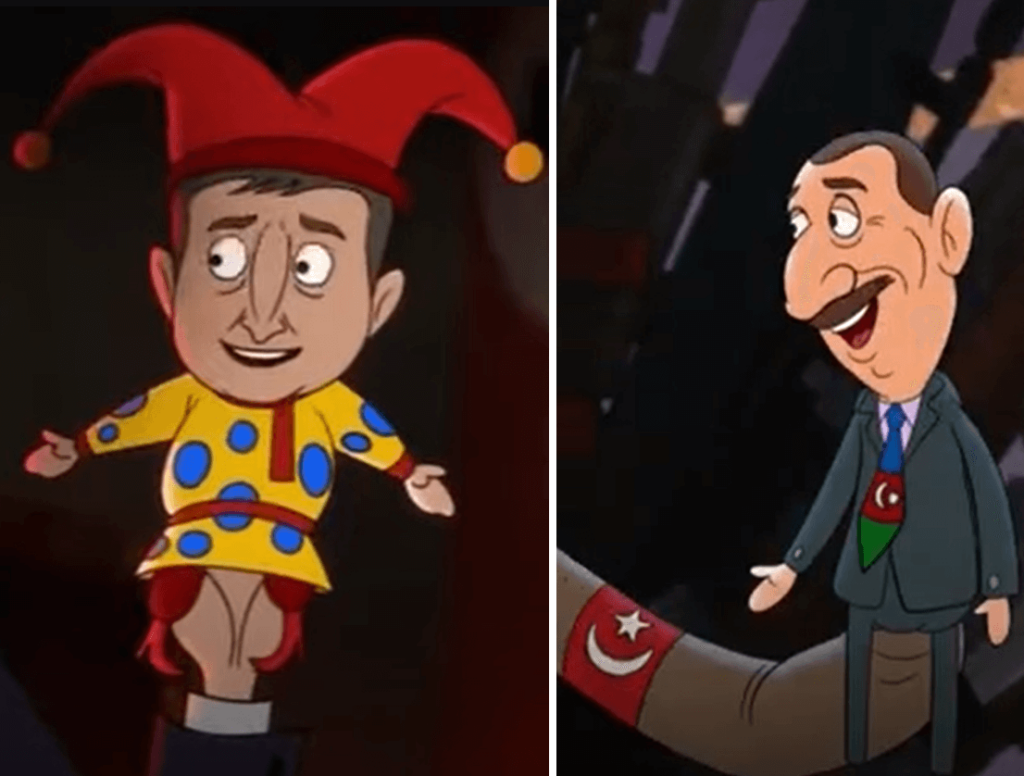
Left: Puppet of Volodymyr Zelenskyi from the fake Russian cartoon; Right: Puppet of Azerbaijani President from David Saakyan’s cartoon
This way, Russians try to present Ukraine as a “Nazi” country that launched an invasion of Donbas in 2014. In reality, it was the opposite: Russia illegally crossed the Ukrainian border and occupied Crimea, as well as parts of Donetsk and Luhansk regions, in 2014.
As with covers, Russians try to create cartoons on current issues in Ukraine. For instance, in May 2024, they circulated a cartoon by the company Ukraine.Inc about the “expired” Volodymyr Zelenskyi, implying his presidency’s term had ended. In July, another cartoon in the same series “buried” the president, showing him in hell witnessing his “sins”, including the “killing of civilians and soldiers”. Both examples clearly reflect Russian narratives claiming Zelenskyi is allegedly illegitimate and responsible for civilian and military casualties in Ukraine.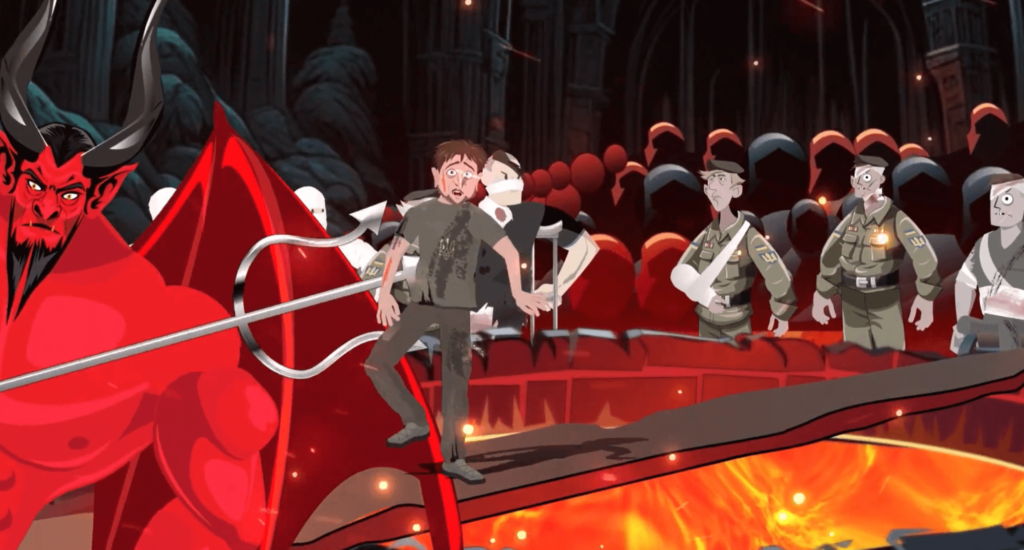
Screenshot from the cartoon about “Zelenskyi’s hell”, circulated by Russians
Ukraine.Inc is a project that produces short propaganda cartoons discrediting Ukraine. Its domain is registered in the US, and the content is mainly distributed by foreigners. Russians target this audience to undermine trust in Ukraine while whitewashing Russia’s war crimes.
Additionally, some cartoons find their way into Russian Telegram channels to distract Russians from domestic issues. The influence logic is simple. First, propagandists publish text messages about “neo-Nazism” among Ukrainian soldiers (rumors or insider “information”), and then they layer “evidence” — covers, cartoons, and fake photos — to reinforce the narrative. In the end, a Russian viewer is left with a “puzzle” of theory and “proofs”, forming a changed perspective. This person is then ready to share the narrative with friends or, worse, bring it to the civilized world.
Deepfakes
Deepfakes are a unique type of fake video that has gained popularity with the development of artificial intelligence. Propagandists take authentic footage of a public figure and use AI to alter their appearance or words.
For example, in January 2024, users shared a video showing Volodymyr Zelenskyi dancing a belly dance to a Russian song. In reality, his face was edited into the footage. The original dance, performed to Eastern music, was by a completely different person.
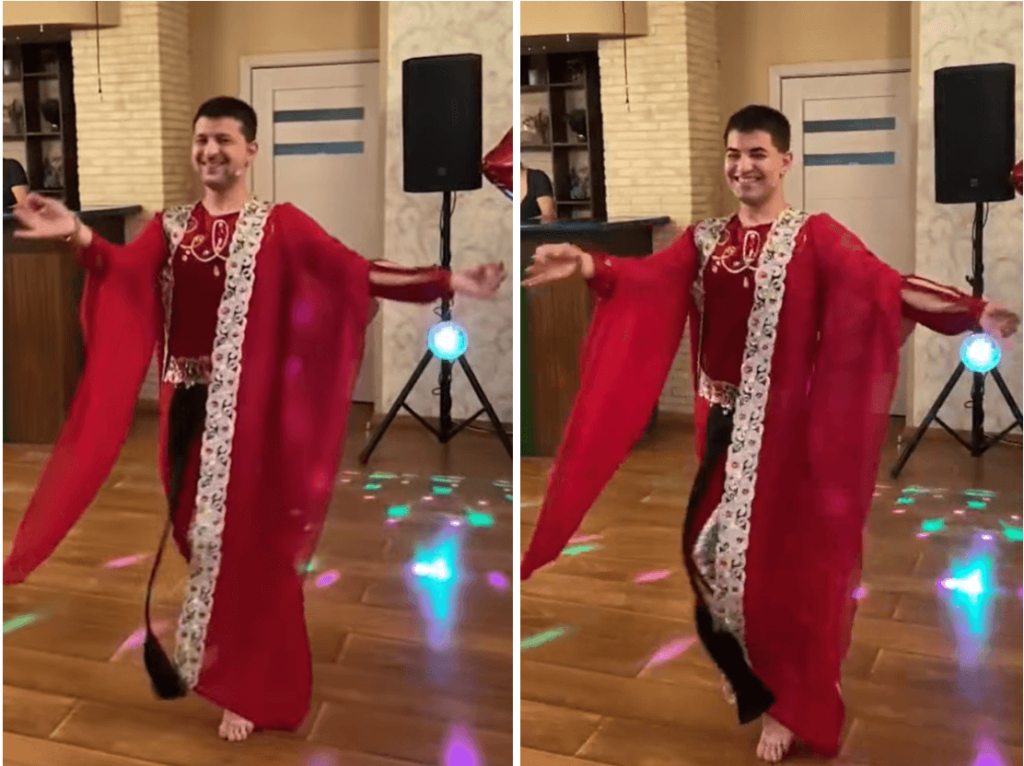
This video spread not only in Ukrainian and Russian-speaking segments but also among international users. The disinformation mainly targets the latter audience, as Ukrainians would likely dismiss the video as a joke. However, on the international stage, such deepfakes could influence perceptions of Ukraine, including military and humanitarian aid.
Satirical Telegram channels
If you thought Russian Telegram channels were limited to military bloggers and “RIA Novosti”, you are wrong. Among them are satirical channels that clearly state in their descriptions that they publish fake news and parodies of political events. For example, in the context of Ukraine, the authors create fake news about events in the Kursk region, statements by politicians, or the Ukrainian Armed Forces commander.
This might seem harmless, but among these jokes, which gather tens and sometimes hundreds of thousands of views, Kremlin narratives are subtly pushed. For instance, one satirical Telegram channel endorses the removal of a Pushkin monument in Ukraine, adding that “there’s no place for him in a pigsty”. Such “humor” once again discredits Ukraine. Another satirical channel posts an image of a Ukrainian “victory car” depicted as a pink pig, mocking the absurdity of the “victory plan” and undermining Ukrainians’ efforts in their fight.
These posts might be taken as satire. Yet, “between the lines”, they still promote the same narratives as Skabeyeva and Solovyov. Even though the authors state in the description that they publish fake news, not all users read it. Consequently, users may share this content as real news, creating an additional threat.
Screenshot of a post from a Russian satirical Telegram channel

Screenshot of a post from a Russian satirical Telegram channel
Does “hahaganda” exist in Russia itself?
In short, no. Dictators love mocking their opponents but do not tolerate being mocked in return. Russian TV does feature comedy shows like KVN, Comedy Club, and Ural Dumplings. However, their jokes generally align with the “party line”, avoiding any criticism of Putin and his inner circle. Russians themselves admit that “censors” in the media ensure no jokes about Russia’s leadership make it through.
In 2019, Russian State Duma deputy Vasily Vlasov called Comedy Club and Nasha Russia disgusting for their jokes about lawmakers, accusing them of blaming deputies for “all of Russia’s troubles”. Meanwhile, Russian publicist Alexander Dugin went so far as to claim that humor originates from the devil.
Russia bans not only jokes about its leadership but also those that “spoil” the image of the Soviet Union. In 2017, the foreign film The Death of Stalin, based on the eponymous French novel, was released. The film depicted the internal political struggle for power among Politburo (Political bureau) members. However, in Russia, it was almost immediately pulled from theaters and banned due to its “unfavorable portrayal” of historical figures, including Georgy Zhukov, and for “desecrating” Soviet historical symbols such as the anthem, orders, and medals.
What is the danger of “hahaganda”?
Undoubtedly, everyone has the right to joke and choose the topics and forms of their humor. Humor lifts the mood, and a good joke can defuse tension. However, it is essential to distinguish when the purpose of a joke is laughter and when it is to spread a narrative based on lies.
The audience for Russian “jokes” is diverse, and propagandists tailor them for different markets. Foreign-language covers and cartoons, though seemingly aimed at international audiences, also reinforce the narrative that the West is allegedly tired of Ukraine. Thus, they are broadcast to both Ukrainians and Russians. Propagandists exploit the emotions of the former and maintain an illusion of an alternate reality for the latter.
It is challenging to defend against Russian “hahaganda”, as any counterargument can be met with, “Don’t you get the joke? Don’t you have a sense of humor?” This is the hidden danger of “hahaganda”. Entertaining content spreads quickly because humorous messages are easier for audiences to digest. Russians understand this and use satire as a cover to promote narratives favorable to them. Moreover, humor appeals to emotions and creates an altered reality where certain ideas may be exaggerated or invented. To avoid falling for “hahaganda”, it is crucial to follow news channels that provide balanced and verified information. Additionally, it is best to avoid consuming Russian content altogether, as it can misinform and cause harm.
Photo: depositphotos.com/ua
Attention
The author doesn`t work for, consult to, own shares in or receive funding from any company or organization that would benefit from this article, and have no relevant affiliations

